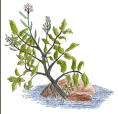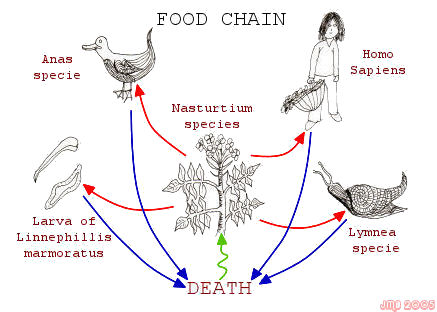|
Watercress
Ecology, Physiology
|

|
Habitat |
Streams, ditches, flushes, rivers, open watercourses. Enjoys slightly alkaline water at 10c partial shade, dlislikes deep shade. As an aquatic it is able to assimilate low light levels. Discolours if exposed to strong sunlight. Climate mezothermic, average light and temperature levels. Able to withstand frost, but not if river freezes for long periods. Dislikes mountainous aspect and grows best at altitudes of <300m. |
Distribution |
Lowland Britain and Ireland. Most of Europe and Russian Asia. Altitudes below 300m North 61 N to Shetland, 58 N Scandinavia, 55 N in Asian Russia. Strong populations where wild variety is cultivated in South England and the Continent. |
Anatomy & Adaptations |
Hydrophyte: Grows in a wet situation and is usually submerged. It is interdependable on the risk of water supply, which must be kept out of leaves and regulated through roots. They have adapted to this situation by having finely divided leaves, giving a large proportion of surface to bulk and has a broad lamina with a smooth surface. Stomata are absent form the submerged leaves, but present on the exposed upper foliage. The shoots contain large air spaces. These provide an internal enclosed atmosphere where gaseous exchange can take place, thus helping to meet the difficulties of diffusion, which on the exposed foliage is slower than sometimes required. The texture of the plant is limp, and dries quickly in the air owing to the defect in cuticular protection. This complex anatomy explains why the plant is perennial and does not dormate, as a constant water supply is available also. Leaves are arranged in a spiral fashion to make full use of the sun, also light conditions are magnified below water, which may be a reason for it returning to water? Roots are strong and embedded in the soil, if growing in a fine sediment it will be regular and well formed. in a stony situation it will wrap around rocks and provide a good anchorage. |
Mycrrorhiza |
Is absent in this particular genus, and probably most of Cruciferae, which is a rare exception of plants. This is probably because it is growing in nutrient rich soil, in water, and does not need fungi help. |
Physiology |
Active Ingredients:
Mustard and gluconasturtiin. Vitamin C, essential oils, iodine, a source of
carotenes, precursor of Vit A.
|
Food Chain |
Is eaten and utilised primarily by man and is enjoyed by water snails and ducks, swans. Various larvae eggs hatch upon it including Caddis Fly and May Fly. Also attractive to various water borne pathogens, bacteria. Could well be utilised by fish. |

|
|
Collated by James M. Burton as part of H.N.D. course at Pencoed
Agricultural College. Taxanomical information correct as of 06:06:97.